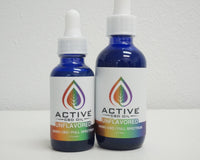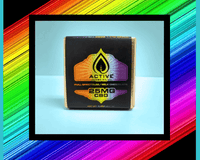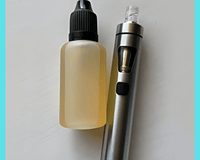In the hemp plant (Cannabis Sativa L) there are suggested to be over a hundred different cannabinoids that are chemical compounds each with their own molecular structure and therefore offer their own unique potential therapeutic benefits. Among the most commonly known cannabinoids are cannabidiol (CBD) and tetrahydrocannabinol (THC), however as research progresses we are continually learning more about several other important cannabinoids like CBG. What does CBG mean and what is CBG oil? CBG is an abbreviation for cannabigerol and is considered a minor cannabinoid that is only found only in smaller percentages in a mature cannabis plant. If you are asking what's CBG vs CBD, this article we will be discussing in depth about CBG and CBD focusing on their similarities and differences to help you discover which cannabinoid might offer the medical benefits best suited for your needs.

CBG vs CBD
Before exploring deeper into some of the similarities and differences between CBG vs CBD oil, we will first explore more about their original state as their acidic cannabinoid forms; Cannabigerolic Acid (CBGA) and Cannabidiolic acid (CBDA). Acidic cannabinoids are raw compounds found naturally in hemp plants that have an extra carboxyl group (COOH) attached to the end of the main structure of each cannabinoid and are considered the precursors to all other cannabinoids as we know them in their neutral forms such as CBG and CBD. In 1975 Israel scientists isolated CBGA, the acidic or carboxylated version of CBG and in 1996 that Japanese researchers discovered that CBGA is the biological origin or building block of all other cannabinoids in cannabis plants including CBD, THC, CBN, CBC and THCv. The acidic version of CBG was appropriately nicknamed “The Mother of All Cannabinoids”as it preceded all other acidic cannabinoids. Researchers also found that CBGA is broken down by the hemp plant’s natural enzymes into other acidic cannabinoids, such as CBDA, THCA, and CBCA. With this in mind, CBG will generally be extracted from younger hemp plants whereas CBD will typically be extracted from more mature plants. Both CBG and CBD are converted from their acidic versions into their activated or neutral counterparts when they undergo decarboxylation; a loss of a carbon atom from a carbon chain which can occur due to aging or heat during extraction processes, combustion, and vaping.

Diagram showing CBGA (left) converting into CBDA (middle) by the plant enzyme CBDA Synthase and then converting into CBD (right) through decarboxylation.
So far there has been a heavier focus in research on the activated versions of the cannabinoids CBG and CBD, however some studies indicate that their acidic versions of CBGA and CBDA both demonstrate similar therapeutic benefits to their activated versions, but with less effectiveness. A more recent study tested the effectiveness of acidic cannabinoids to treat or prevent infection by coronavirus-2 (SARS-CoV-2) and its variants. They concluded that CBGA and CBDA prevented infection of epithelial cells by SARS-CoV-2 spike protein and prevented entry of live SARS-CoV-2 into cells, which could indicate that both CBD and CBG may also be effective. However more research with human trials is needed to fully understand the potential therapeutic effects of these acidic cannabinoids.
CBD vs CBG
If you are curious to learn more about cbd vs CBG oil then it may be helpful to understanding how CBG and cbd interact within our body. Researchers discovered that there is a system in our body called the endocannabinoid system (ECS) that allows us to interact with cannabinoids such as CBD and CBG. The main role of this system is to regulate homeostasis or balance for our body. The endocannabinoid system is made of several parts including endocannabinoids, cell receptor sites, and enzymes that all work together in unison to help maintain homeostasis.

The body naturally produces its own endocannabinoids, endo coming from the Greek root word “endon,” meaning within. They are made from fat-like molecules within cell membranes and are synthesized as needed whenever the body detects any imbalance rather than being packaged and stored for later use. Among the first endocannabinoids to be discovered were 2-arachidonoylglyerol (2-AG) and Anandamide (AEA), the latter of which is commonly known for being responsible for the natural “runner’s high” produced from exercising.
These endocannabinoids are suggested to be similar in structure as phytocannabinoids (stemming from the Greek root “phyton” meaning plant) found in hemp and cannabis plants like CBD and CBG that bind to the same cannabinoid receptors sites CB1 (found mostly in the central nervous system and brain) and CB2 (found in more peripheral parts of the body outside of the central nervous system, including cells of the immune system). These cannabinoid receptors sites are located on the surface of various different types of cells in the body. Cannabinoids are often described as keys that fit into place of the locks that are the CB1 and CB2 sites, which then send signals between nerve cells within our body to kick start the appropriate cellular response to bring the body back into homeostasis.

The last part of the endocannabinoid system are the enzymes that help break down the endocannabinoids after they are used. The main enzymes are Fatty acid amide hydrolase (FAAH) which breaks down AEA and Monoacylglycerol lipase (MAGL) which breaks down 2-AG. They help ensure that endocannabinoids get used when they’re needed but not longer than necessary to help bring the body back into balance.
When it comes to CBG vs CBD effects both CBG and CBD are suggested to have an affinity to bind to both CB1 and CB2 receptors. Although studies suggest that CBG has higher affinity to bind more to CB2 receptors whereas CBD has shown an equal, albeit low affinity to bind to either CB1 or CB2. However each cannabinoid has their own chemical structure and so their potential therapeutic effects while similar in many areas do have a few major differences when comparing CBD vs CBG effects. Another major difference of CBD vs CBG is that CBD is also suggested to impact the overall levels of endocannabinoids in the brain referred to as the “endocannabinoid tone.” Studies have shown that CBD inhibits the FAAH enzyme, preventing it from breaking down AEA, thus increasing the endocannabinoid tone of AEA in the brain. This is suggested to be another useful way that CBD may help treat anxiety disorders.
CBG oil vs CBD
After giving more context of whats CBG vs CBD in regards to their orgins and how they work with our ECS, we can now explore CBG effects vs CBD. Both CBG and CBD are non-intoxicating cannabinoids and do not produce a ‘high' unlike THC which is the cannabinoid suggested to be responsible for producing psychoactive effects in cannabis plants. Among the many potential therapeutic benefits, both CBG and CBD are suggested to have their own anti-anxiety and anti-inflammatory properties. Although there are several studies investigating a few specific issues that each may be better suited to help with. Without further ado let's first look into some of these studies about what is CBG good for:

Experimental Inflammatory Bowel Disease (IBD) is a common ailment that involves chronic inflammation in the gastrointestinal tract (stomach and intestines) that may cause other symptoms such as abdominal pain, cramping or bloating from passing a bowel movement, changes in bowel movement and how often someone may experience bowel movements. One 2013 study sought to investigate the potential for CBG to help mitigate and alleviate these symptoms by testing on mice. They concluded that CBG reduced inflammation, attenuated murine colitis, modulated CB2 receptors to reduce nitric oxide production, and reduced reactive oxygen species.
Glaucoma is another common issue that develops when the optic nerve becomes damaged, usually due to an increased pressure in the eye from a buildup of fluid called the aqueous humor. Left untreated glaucoma may even lead to irreversible blindness. Researchers conducted a study to compare the ocular and central effects of delta 9 THC and CBG. In their findings they discovered that both cannabinoids produced a two to three fold increase in aqueous outflow facility which suggests that they could both offer therapeutic potential in the treatment of glaucoma. However in their comparison they found that the systemic administration of delta 9 THC to rats caused negative side effects whereas CBG did not show any adverse reactions.
Huntington’s disease is a rare and inherited condition that causes the nerve cells in the brain to progressively breakdown. This has a negative impact on the person’s well being as this can lead to movement disorders, cognitive disorders, and psychiatric disorders. People with this condition may experience movement issues such as involuntary jerking, muscle problems, unusual eye movements, decreased balance or difficulty with speech or swallowing. Cognitive disorders may include having difficulty organizing or focusing on tasks, lack of awareness of one’s own behaviors, slowness processing thoughts, and trouble learning new information. Psychiatric disorders may include social withdrawal, insomnia, fatigue, suicidal ideation, obsssive-compulsive disorder, mania, and bipolar disorder. One promising study by Spanish researchers sought to investigate the Neuroprotective properties of cannabigerol in Huntington's disease. In the study testing the effects of CBG on mice with Huntington's disease, they observed that CBG encouraged significant neuroprotective properties, improved motor deficits and protected striatal neurons against 3-nitropropionic acid toxicity.
Now that we explored a few conditions that researchers are investigating the potential for CBG to help with, let’s explore a few potential effects CBD may have:
Epilepsy is a common neurological condition where brain activity becomes abnormal and causes seizures, convulsions, spasms, altered sensory perceptions or thoughts, and a loss of awareness or consciousness. According to researchers about one third of patients with epilepsy have a treatment resistant form, so there is a high demand for a natural medicine that may be effective in reducing the frequency and intensity of each epileptic episode. In the same study the researchers gave CBD to 162 children with treatment-resistant epilepsies resulting in a significant reduction in their seizure frequency ranging from 16-55% showcasing CBD and its potential anticonvulsant properties. The first and only U.S. Food and Drug Administration (FDA) approved CBD product, Epidiolex, was specifically studied for its potential benefits to help with epilepsy forms such as Lennox-Gastaut syndrome or Dravet syndrome and shown to reduce frequency of seizures when taken alongside patients regular medication.
Alzheimer’s disease (AD) is a neurologic disorder which causes the atrophy or shrinking of the brain and brain cells to die. It is one of the leading causes for dementia, the loss of memory and other cognitive abilities that inhibit a person’s ability to function independently and may put a strain on their interpersonal relationships. Alzheimers is considered a progressive disease where there will be a slow deterioration of cognitive function over the course of years where at first it may start with signs of mild memory loss to late stages where an individual may lose their ability to communicate or interact with their environment like they used to. Researchers from Australia conducted a study that showed CBD’s ability to prevent the development of social recognition in AD transgenic mice. They concluded that CBD may have the potential as a preventative treatment to help reduce symptoms of social withdrawal and facial recognition.
Traumatic events may occur at any point in time for any individual and often may result in a relatively common psychiatric condition known as post-traumatic stress disorder (PTSD). Symptoms may include reliving the traumatic events through intrusive memories and nightmares, avoidance of distressing triggers, and changes in mood, level of arousal and cognition. Colorado researchers sought to investigate how effective CBD may be in treatment for PTSD and its symptoms in their case series study. They discovered that out of the 11 patients included in the eight week study, 91% of them experienced a decrease in PTSD symptoms. They also observed that CBD seemed to offer relief for patients who reported frequent nightmares as one of their PTSD symptoms. More clinical studies are needed to fully understand the mechanics of how CBD may help, however the anecdotal success from combining CBD with psychiatric medications and psychotherapy seems promising.
CBD vs. CBG
When it comes to choosing the right CBG oil vs CBD oil products there are several factors to consider such as the various methods of consumption and what category of product they fall into.

Among the many different CBG and CBD products, one of most commonly known are CBD oil or CBG oil that are taken under the tongue, holding it there for a minute or two and then swallowing it. Due to all the blood vessels under the tongue, the sublingual route when taking a CBG and CBD tincture is suggested to have a much higher bioavailability or percentage of the cannabinoids actually absorbed into the bloodstream. On average it takes about fifteen to twenty minutes for most people to notice the potential effects which typically last about four to six hours going the sublingual route.
Another popular method of consumption is by ingestion using a capsule or edible like a gummy or chocolate. Although it may take longer to absorb the cannabinoids with this method on average taking between thirty to ninety minutes, they usually last much longer where people have shared a range of six to ten hours so it makes for a great option for people who do not want to take a dose as often as an oil. There are also topical products like lotions or salves that are commonly used for more localized issues such as pain that can be massaged directly to the afflicted areas. For some looking for a faster absorption inhalation from smoking or vaping might be a good option to consider. When smoking CBG vs CBD, most report feeling the effects from inhalation within a few minutes, however while it may offer one of the fastest methods of absorption, it is also the shortest duration comparatively.
When considering what is CBD vs CBG, there are three main categories that either may fall into. The most commonly used in research is what is called full spectrum CBD or CBG where the product is made using the full hemp extract including over a hundred plus other cannabinoids, terpenes, flavonoids, and amino acids that are suggested to come together to create an entourage effect where each active ingredient works synergistically with each other. Full spectrum CBD oils and full spectrum CBG oils extracted from hemp will contain trace amounts of THC of 0.3% or less, which while not typically a large enough amount to produce psychoactive effects, may still run the risk of showing up on a drug screen. The next category is broad spectrum CBG oil or CBD oil which is made using the full hemp extract with the THC removed through a process called chromatography. Broad spectrum is a great option for those looking to gain the entourage effect without any concerns for THC being in their product. Finally the last category is CBD or CBG isolate, where the cannabinoids CBD and CBG are completely isolated from the rest of the hemp plant and considered pure CBD or CBG.


























